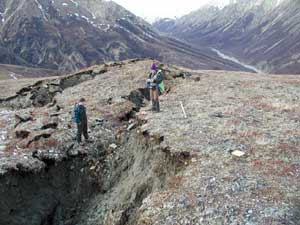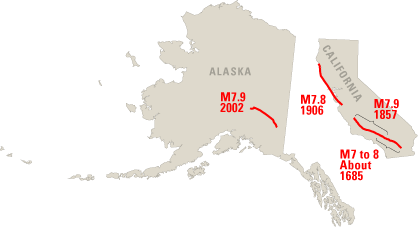

Earthquakes are commonplace
throughout much of Alaska. On average there is a magnitude 7 or greater
earthquake somewhere in or offshore Alaska every 1 to 2 years and a magnitude
8 or greater quake about every 13 years. These quakes occur as a result
of stresses caused by movements of tectonic plates that make up the Earth's
outer shell. In this region, the Pacific Plate moves steadily northward
at a rate of about 2 inches per year and descends, or "subducts,"
beneath the North American Plate.
An irregularity on top of the Pacific Plate, known as the Yakutat block
(YAK), impedes smooth subduction of the Pacific Plate and has caused a
wedged-shaped piece of the North American Plate, the Wrangell Subplate,
to break loose and rotate counterclockwise. The western Alaska Range,
which includes Mount McKinley, the highest peak in North America, is a
zone of compression between the North American Plate and the Wrangell
Subplate. The Denali and Totschunda Faults form the northeastern margin
of the Wrangell Subplate.
The largest earthquakes in the region (magnitudes 8 and 9) occur along the subduction zone and often generate destructive tsunamis (seismic sea waves). These include the second largest quake ever recorded worldwide, the 1964 magnitude 9.2 Prince William Sound earthquake, which killed more than 100 Alaskans. Generally smaller but still powerful quakes (magnitudes 6 to 8), such as the November 2002 Denali Fault earthquake, occur inland along faults like the Denali, Totschunda, and Castle Mountain Faults.

